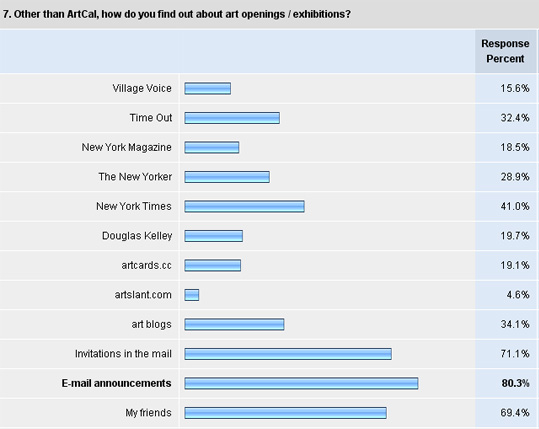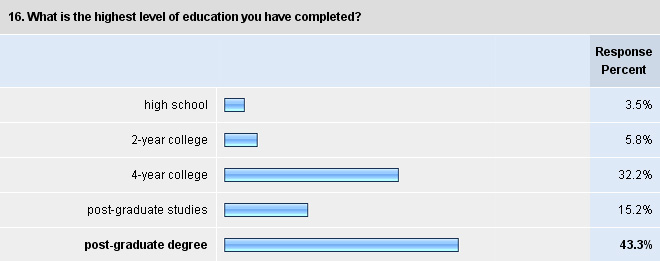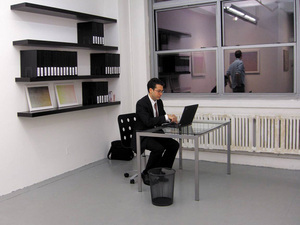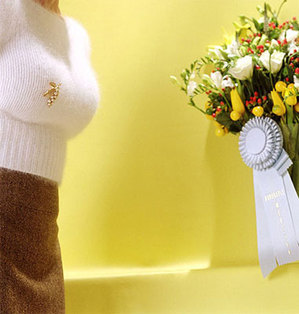This is an archive of the ArtCat Zine, 2007-2009. Please visit our new project, IDIOM.
Recently by Paddy Johnson
Here at ArtCal we seek out under recognized and under represented galleries and venues for contemporary art, specifically promoting the best emerging talent from those fields. Launched November 18th, 2004, what began as a listing service has seen significant growth over the last three and a half years. In 2005 we added images to the site's features, as well as RSS and iCal feeds. At the time, no other art listing website offered such tools, so I imagine the technology made heavy Internet users extraordinarily happy; as an active blogger it certainly made my life a lot easier. ArtCal continued in its Internet pioneering only a few months later hiring me as their listings editor - clearly a high point in their services! Since that time, we launched our newsletter on March 30th, 2006, our beautiful redesign on August 28th 2007, and most recently, ArtCal Zine, the flagship event and reviews publication which debuted on October 4th, 2007.
As ArtCal embarked on 2008 we asked our readers to tell us a little bit more about themselves, and are now ready announce our findings. Through the course of this survey we learned a number of interesting facts, not the least of which is that you all go to a lot of openings! Of those polled, only 5.2% said they didn't go to any receptions at all, where as 50% said they attended at least 1-3 each month, and 31% attend 5-10. 13.3% of you seem to have lives solely centering around openings and arrive at more than 10 throughout the course of 30 days.
ArtCal subscribers tell us that while they use a large number of publications to keep abreast of art openings, over 80% rely on email announcements to inform them of openings. Let this be a warning to all you who have blogs and assume you've told your friends merely by posting an event notice. It turns out email is still the most effective means of reaching an audience, and certainly a good reason to subscribe to our weekly newsletter if you haven't already. Nearly 43.3 percent of our audience have post graduate degrees, closely followed by those 32% with college degrees. We also suspect most of you are sexy, though SurveyMonkey.com has no scientific means of measuring this, except to tell us that 62.5% of our readers are between the ages of 25 and 44. Generally speaking that age bracket is hot, so congratulations everyone who hits that mark. Also congratulations are in order to the 42.8% of you who live in Manhattan. As a member of the 26.6% of Brooklyn dwellers, I look enviously upon you. Interestingly 11.6% of our readership lives outside the United States, which I think indicates an extremely invested demographic in the arts.
Speaking of which, it should not go unmentioned that an extremely high percentage of our readership are also collectors. Of those surveyed, over 49% said they planned to fill their homes with art. Given that 94% of our readers attend one or more openings per month, that we receive over 103,500 page views over that same time period, and that our audience is largely made up of upper middle class well educated readers, we are undoubtedly a desirable, and influential bunch. We are also growing. ArtCal newsletter subscribers hit 2000 in January, a number that continues to climb. Based on your feedback we will be adding a number of new features over the course of the next few months. Our aim as always, is to build upon and improve a service we're already really proud to offer all of you.
"This is hilarious" I told artist Dan Levenson, pulling out a thong ornamented with the floral Little Switzerland gallery logo. The sale of t-shirts not to mention exhibition branded lingerie falls considerably short of common within fine art circles, though so do corporate identities with no tax id numbers, bank accounts or regular hours of operation. Without knowing Little Switzerland's background as a conceptual art project about the branding and marketing of art, it might be just as easily confused for a front of some nefarious business enterprise.
Those familiar with the artist's activist efforts during MoMA's grand reopening however, would not make this mistake. Protesting the museum's raise in admission price from 12 dollars to 20 in 2004, Levenson's FreeMoMA.org campaign consisted of a wearable human sized currency, extended protests outside the museum, and informational fliers describing the problem. Since the high profile days of FreeMoMA, Levenson has continued creating work that addresses similar ideas, while maintaining lighthearted approach. "I have an interest in all the ways art work is disseminated that is extraneous from the object" Levenson explained, "the marketing, the advertising, the word of mouth, the hype… and just the business of the art gallery is fascinating to me and a lot of what Little Switzerland is about."
ArtCal Zine: And I imagine your position as an art maker gives you an important and unique perspective…
Dan Levenson: As an artist I am trying to co-opt that business and make it part of my artwork. So I'm interested in the postcards that galleries send out, I'm interested in the catalogs that they print, the essays that are in those catalogs. I love art gallery logos, I love art gallery letterhead, I love printed art gallery advertisements.
AZ: Speaking to this, can you talk about how you feel Little Switzerland identifies itself as an emerging artist gallery?
DL: Well, it’s flexible in terms of the forms it could take, but the story that I have now is that it is a gallery that began in Zürich in 1996 and then moved to Berlin in 1997 where it ran through three seasons and then closed in 1999. So it was an emerging artist gallery that represented a group of emerging Swiss artists. They were all young, they all knew each other, they all went to the same art school and they were all sort of “true believers” in my mind.
AZ: What are true believers?
DL: That’s something that I have a hard time explaining but I guess I divide artists along a spectrum of iconoclasts and true believers, and Little Switzerland is a gallery more for true believers than for iconoclasts. It’s an emerging gallery, so it was a little bit too loud and a little bit too promotional, the way that emerging artist galleries tend to be. We’ve spoken before about Bellwether and how their early graphic identity was a little bit louder and kitschy-er.
AZ: Yeah, their website was an illustrated storefront with someone walking in…
DL: Yea, that’s right! Which I thought was very very cool. And I loved that when they moved to Chelsea they had that pink neon sign that had their logo, which was Bickham Script, a very florid, 17th century-esque font. And of course they’ve toned it down now…I think they are aspiring to something a little bit more respectable and upscale and more Chelsea than Williamsburg. So Little Switzerland is more downtown and they have this kind of loud downtown logo, and then they print t-shirts and they have a kind of whole promotional merchandising aspect that I’m not aware that any real gallery has ever done. I don’t think that galleries generally sell t-shirts and coffee mugs and beer steins and stickers and that kind of stuff, but Little Switzerland does. And more than that, they sort of force their artists in the compromising position of having to model the clothing. So these are the artists modeling.
Tom Moody starts a rowdy discussion about Diana Kingsley's recently removed photograph, Blue Ribbon, 2005 at 55 5th Avenue in NYC (at 13th Street). The photograph pictures the torso of a sweatered large breasted woman opposite a winning floral arrangement and was taken down due to a complaint that the work was insensitive to those visiting a neighboring mammogramy office. Moody takes the position that the complaint stifles expression where as the guardian's Ana Finel Honigman believes the work was inappropriately placed. I suppose those who are facing the possibility of losing their breasts might not want to see a picture of someone who presumably will be keeping theirs for some time, but it's hard to imagine a more tame photograph than this. I want to be sensitive, but these are the kinds of complaints that lead to the exclusive display of tepid landscape painting. Also see artinfo for a brief summation of the story.
This weeks Impressionist and Modern auction sales started out tame at Christies, who faired reasonably given a slumping economy, and led to a rather disasterous evening at Sothebys. That auction totaled 269.7 million, falling significantly below their presale low estimate of 355.6 million. Apparently the most disappointing moment of the auction came early on, when The Fields, a Van Gogh painting estimated to sell for as much as 35 million, drew not a single bidder. Sotheby's stock responded yesterday by plummeting 14.23 percent. Culturegrrl writes up a storm on this subject here, here, and here.
Tyler Green writes that while Dave Hickey is probably the most admired art writer of the moment, Laurence Weschler could stand to see a little more attention. I couldn't agree more. His book, Seeing is Forgetting, a biography of Robert Irwin is a must read for any artist. I might also advise artists to read Hickey with a few more grains of salt than many do. There are far too many hipster artists overly concerned with beauty and the whims of pop culture, all of whom have read Air Guitar and treat it as though it were the bible.
Paul Schmelzer interviews communications scholar Bob McChesney about the FCC ownership vote and net neutrality. If there was any question that the FCC has been acting rather shadily, McChesney clears this up in the except below,
Kevin Martin has reopened a review of its media ownership rules, as it’s required to by law. And he agreed, and the FCC agreed after the last time the rules were thrown out in the court system that to make sure it’ll past legal must this time they would hold at least six public hearings on what people think of these rule changes. The last one is coming on November 9 in Seattle. Chairman Martin of the FCC is making it clear that he is determined to change the rules – he’s been public about this – as quickly as possible, as dramatically as possible, and really has no concern whatsoever with following the spirit of the process where the public hearings hold any value. He’s given in almost every case minimum possible notice to the community that’d they’d be having hearings. The last two, literally a week's notice. And these are supposed to be hearings to solicit public opinion from across the board. They’ve tried to put them during daylight hours when working people can’t get away from work. And he’s made a mockery of the process.
To read the full interview click here.
ZINE
HOME
TIPS / COMMENTS
CATEGORIES
CONTRIBUTORS
- Greg Afinogenov
- B. Blagojevic
- Adda Birnir
- Susannah Edelbaum
- Julie Fishkin
- Paddy Johnson
- Jessica Loudis
- Christopher Reiger
- Andrew Robinson
- Peter J. Russo
- Blythe Sheldon
- S.C.Squibb
- Hrag Vartanian




